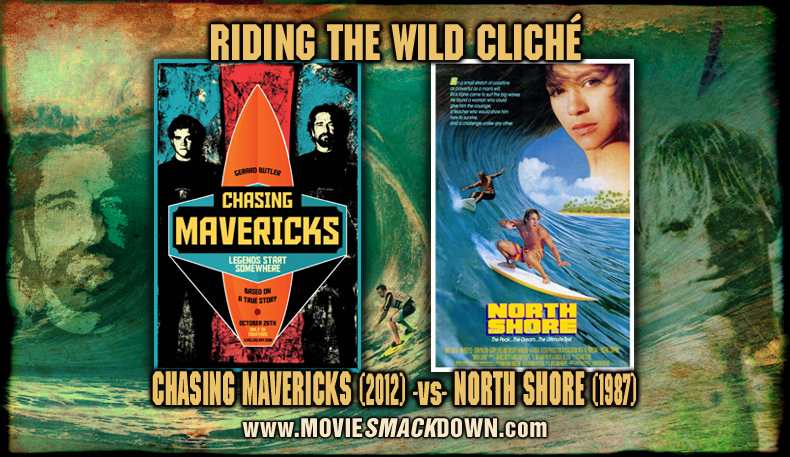
The Smackdown
Earnest young hero struggles to master a sport and is aided by a gruff and/or reluctant mentor. Yeah, we’ve seen it before, again and again, from Rocky to Hoosiers to Karate Kid. But there must be something we love about the formula, right? Something that speaks to the human spirit, embodied in a young athlete trying to rise above his limitations to achieve something greater than anyone thought possible.
Here, the sport is surfing, which means each of these two competing films, Chasing Mavericks, which premieres this weekend, and 1987’s semi-cult-classic North Shore, has the opportunity to inspire and humble us with nature’s awesome beauty. Of course, it’s just as likely that each might drive non-sports fans like me crazy by drowning us in a tidal wave of movie clichés.
Come on, admit it — if you know any surfers, and especially if you only know them from previous films, you get the impression that, while they may be extremely talented athletes, they often seem to have swallowed too much saltwater (Keanu, I’m talking to you). So the challenges here are many, and the stakes are high: Which, if either, of these movies is the Big Kahuna?
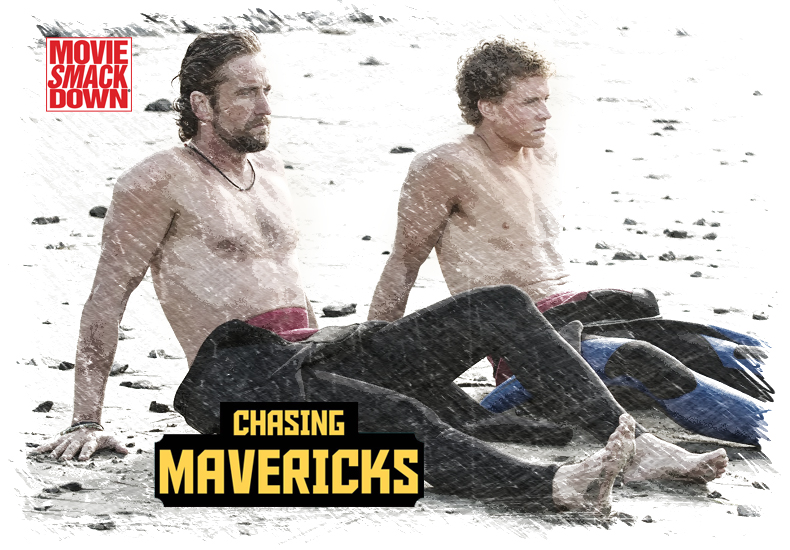 The Challenger
The Challenger
Chasing Mavericks is based on a true story about real-life surfing champ Jay Moriarty (played by Jonny Weston). When fifteen-year-old Jay discovers that legendary Mavericks waves are real, he begs his neighbor and local surfing legend Frosty Hesson (Gerard Butler) to train him to surf the massive offshore break, which are indeed real and can be found about a mile off the coast of Northern California, south of San Francisco.
At first, Frosty has no interest in helping the eager young man, but he gives in after his wife (Abigail Spencer) impresses upon him that Jay is going to try with or without his help. With only twelve weeks to get Jay ready, the two begin a rigorous training regimen. Frosty isn’t teaching Jay to surf so much as he’s teaching him how to survive. The Mavericks waves are monsters, sometimes reaching as high as 80 feet.
As Frosty tells Jay, “One wrong turn and you’re hitting the water like concrete at 50 miles an hour.†As Jay and Frosty train, they begin to form a father-son-type bond that will change both of their lives.
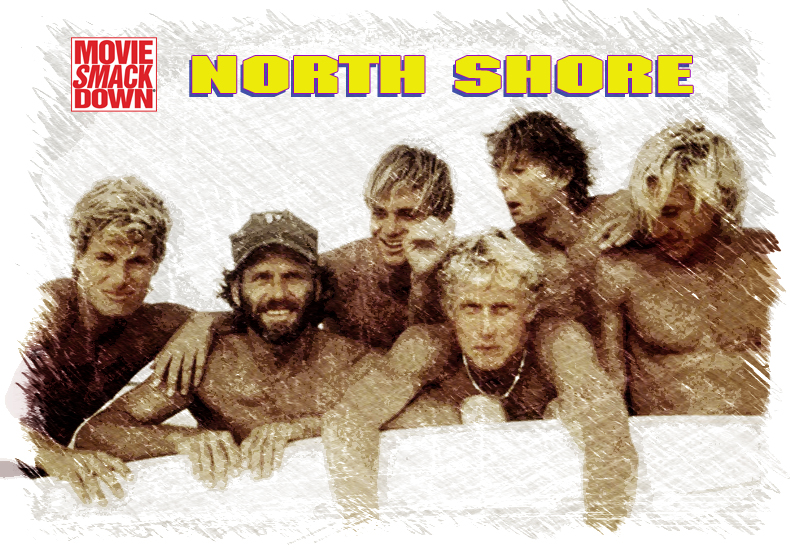 The Defending Champion
The Defending Champion
Arizona wave-pool champ Rick Kane (Matt Adler) wins a local surfing competition and decides to use the $500 prize money to go to Hawaii, where he can surf the really big waves on Oahu’s North Shore. Upon arrival, however, he gets a rude awakening when his stuff is stolen and he runs afoul of the Hui, a tough native Hawaiian surfing club. Even worse — and in a major gut-check — he discovers that, alas, what passes as a champion surfer in Arizona, doesn’t quite cut it in Oahu. Rick is woefully inadequate to the challenge at hand.
Luckily, he strikes up a friendship with Turtle (John Philbin), a surfboard sander, who teaches him about island customs and introduces him to Chandler (Gregory Harrison), a local surfing guru. In exchange for help around his board shop, Chandler gives Rick a place to crash and agrees to teach him how to really surf. Rick also starts a romance with a local girl named Kiani (Nia Peeples), despite the disapproval of her cousin Vince (Gerry Lopez), a member of the Hui and a rival surfer.
The Scorecard
Both Chasing Mavericks and North Shore suffer at times from waves of movie clichés. Mavericks manages to stay afloat by making the film less about surfing and more about the characters’ relationships. Jay’s father abandoned him and his mother when Jay was eight years old. It’s entirely believable that he found a father figure in the likes of gruff-but-ultimately lovable Frosty, whose parents died when he was young. In turn, Frosty, through his relationship with Jay, learns to connect with his own children. Newcomer Weston gives a decent performance as the enthusiastic Jay, and Butler is commendable as Frosty, though he struggles to keep his American accent consistent. (How many Scottish surfers are there, really?)
In North Shore, by contrast, Matt Adler as Rick is — to put the best possible spin on it — quite bland. He and Harrison don’t have the chemistry or father-son bond that Weston and Butler do. John Philbin is mildly amusing as Turtle, though he mostly falls back on the dumb-blonde-surfer stereotype. Nia Peeples is fine as Rick’s love interest, but she isn’t given much to do other than look nice in a bikini — which I must say she does exceedingly well.
While most of the other surfers in North Shore are stereotypical empty-headed beach bums, Chasing Mavericks actually showcases the true athleticism of the the big-wave surfers quite nicely. These guys study the waves and currents and constantly train mentally, physically and spiritually. While Harrison’s Chandler touches on some of these areas, he’s out of his depth and ends up coming across as a zen-master cliché.
One of the main flaws in Chasing Mavericks is the character of Jay. He’s plenty likable, sure, and that’s part of the problem. He’s a damn saint. The real Jay Moriarty died the day before his 23rd birthday during a diving accident, and the film reveres him a little too much. He’s so perfect as to be unbelievable. Even his friends tell him, “You only see the good in things,†and, “Not everyone can be as perfect as you.†However, despite this shortcoming, his character is a million times more empathetic than Rick, who is so colorless and two-dimensional that you never really root for him.
While the majority of Chasing Mavericks is about Jay preparing to surf Mavericks, it feels like North Shore only dedicates fifteen minutes to Rick’s buildup. When Chandler agrees to train him, Rick can barely get up on the board. One scene dedicated to talking about the ocean and a five-minute montage later, and Rick is shredding waves like a pro. So, in terms of pacing and credibility, Mavericks comes out ahead.
Working from Jim Meenaghan and Brandon Hooper’s story and Kario Salem’s screenplay, acclaimed directors Michael Apted and Curtis Hanson, expertly capture Chasing Mavericks’ colossal and terrifyingly authentic waves (Butler is said to have nearly drowned during filming). When the sound of the rushing water crashes through a theater with a decent system, audiences can’t help but sympathize with those big-wave surfers who end up underneath the tons churning, roiling whitewater. By comparison, the water scenes in North Shore are far less impressive. While the surfing montages are visually interesting at first, they get repetitious really fast. Each surfer seems to shred the waves in exactly the same way. In comparison to the 50-to-80-foot swells of Chasing Mavericks, North Shore seems as tame as a tempest in a bathtub.
The Decision
It’s surprising to see how far surf movies have come since North Shore got gremmies’ adrenaline pumping 25 years ago. Both these films are formulaic to a fault, but Apted and Hanson’s heart-stopping action sequences and the touching, if occasionally sappy, storyline of the growing bond between Jay and Frosty make Chasing Mavericks a far superior film. It hangs a solid seven out of ten, while North Shore, sadly, wipes out.





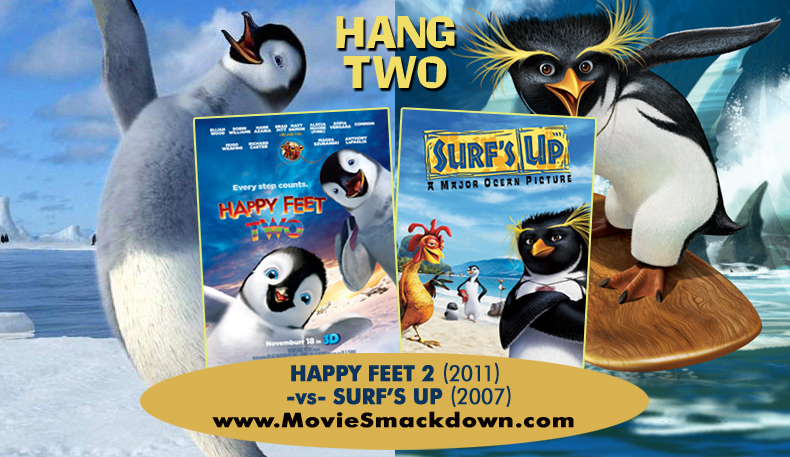
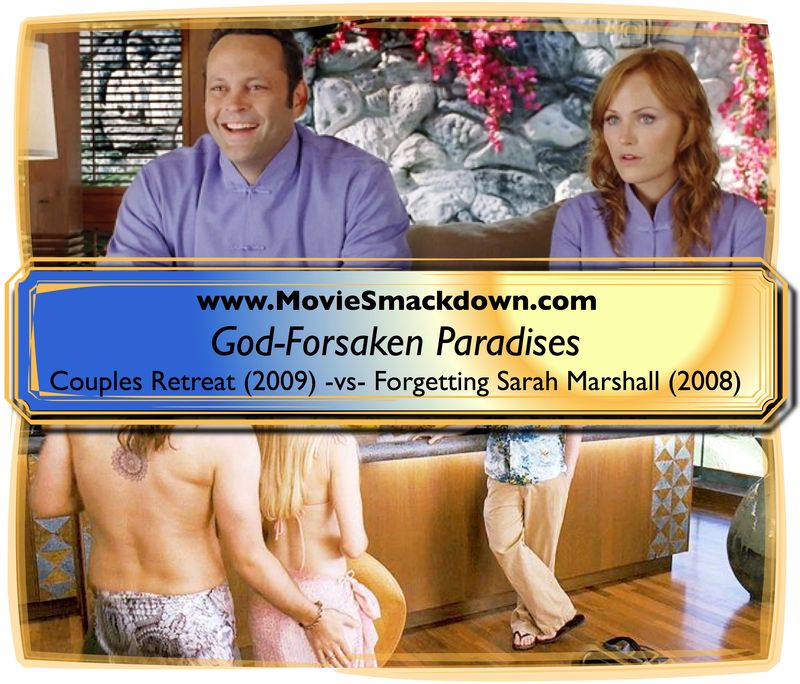
No way Chasing Mavericks is better. I mean, Chasing Mavericks is a rip-off of North Shore. It imitates the same master shaper training a young surfer aspiring to surf the big waves. Chasing Mavericks will soon be forgotten while North Shore rides on
“North Shore” clealry the winner. The tale has endured as a cult favorite for 25 years.